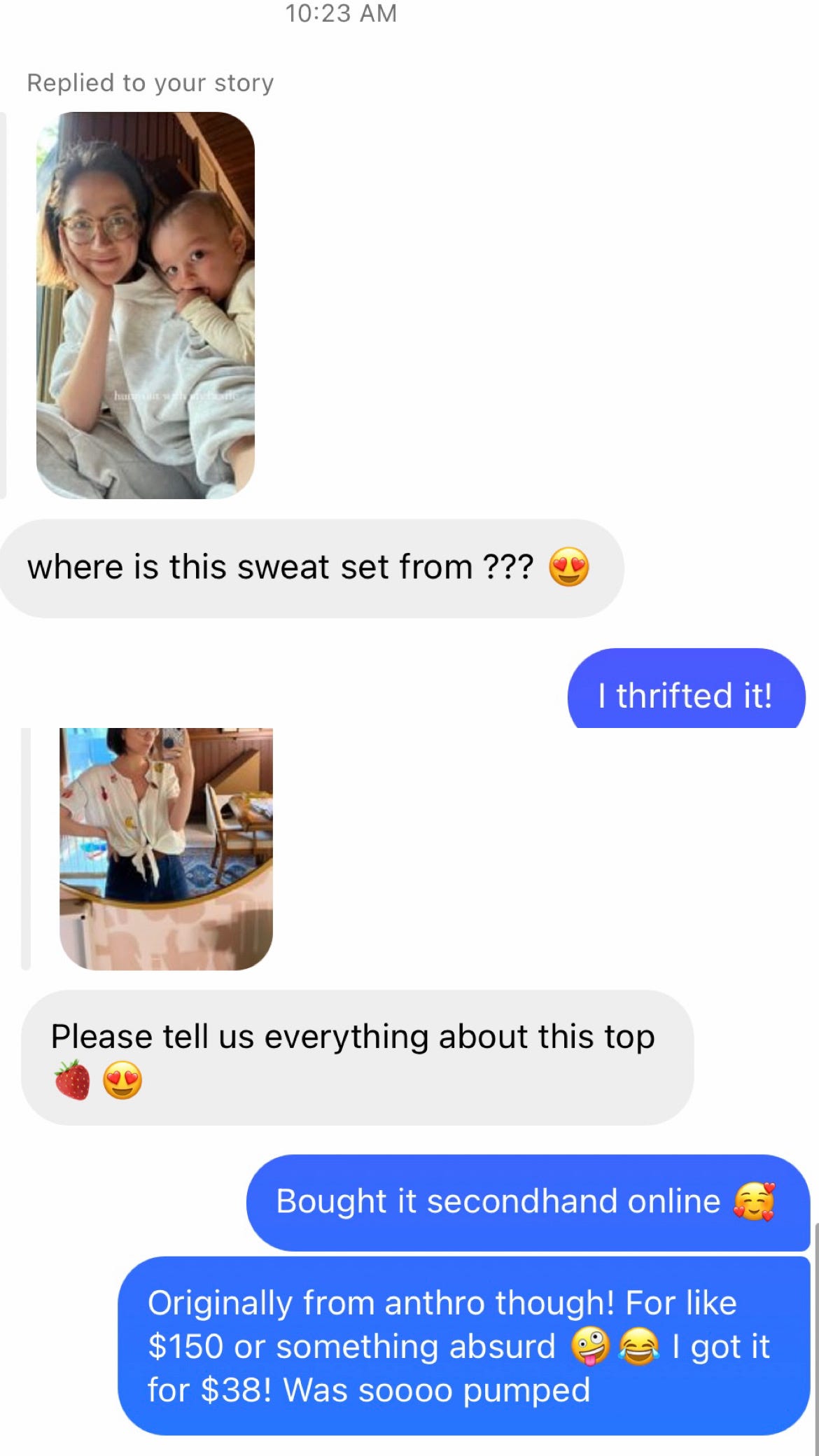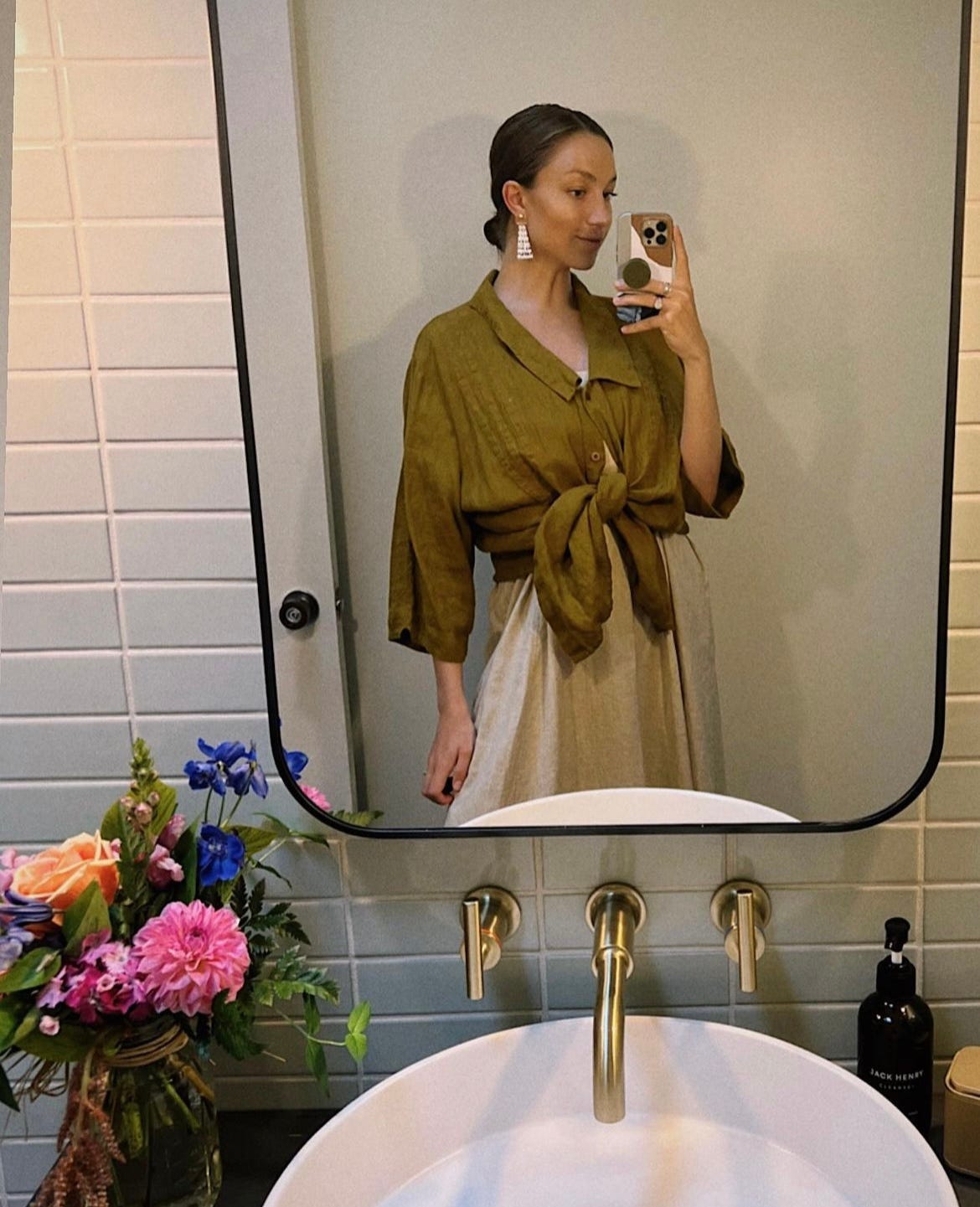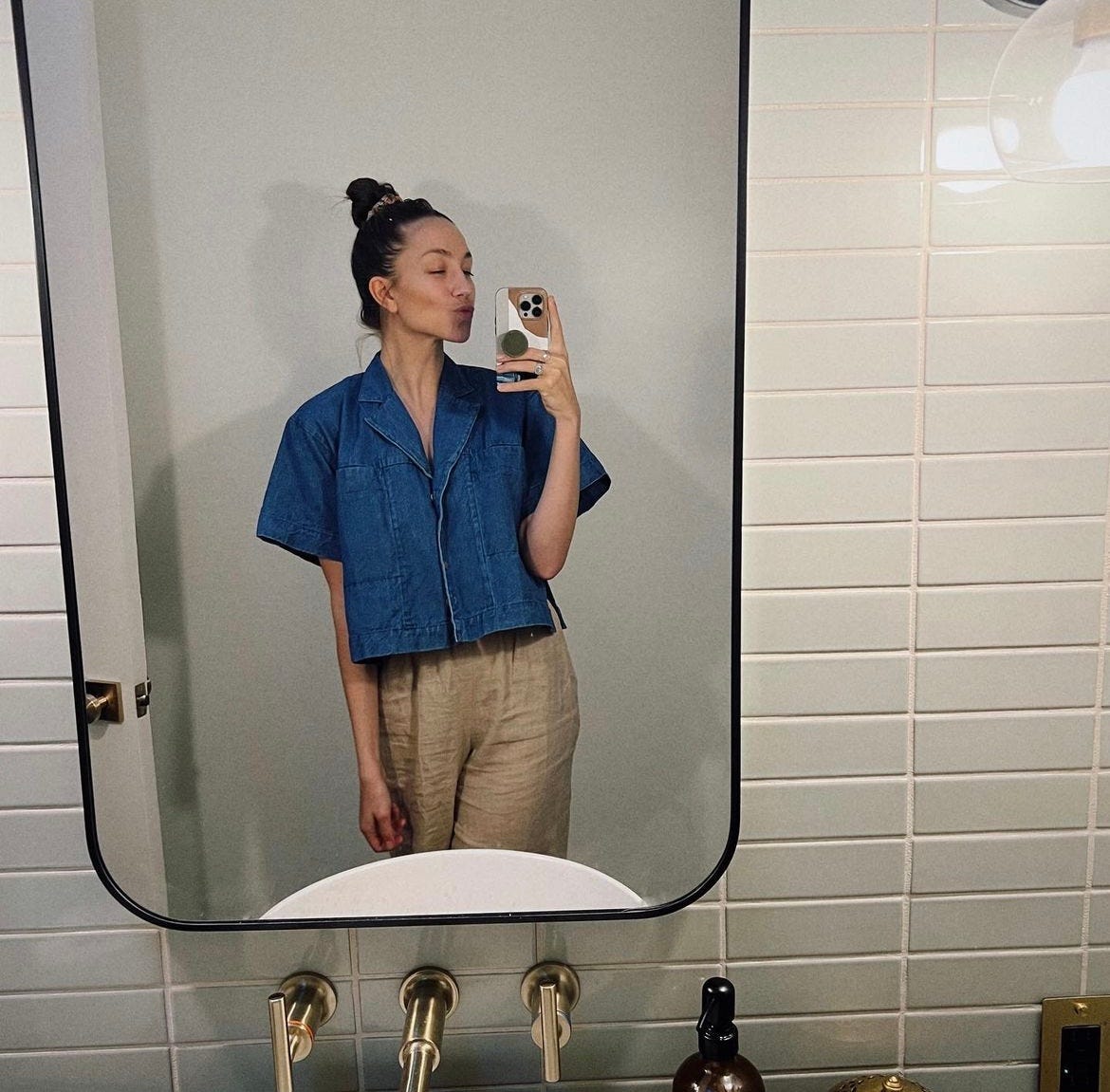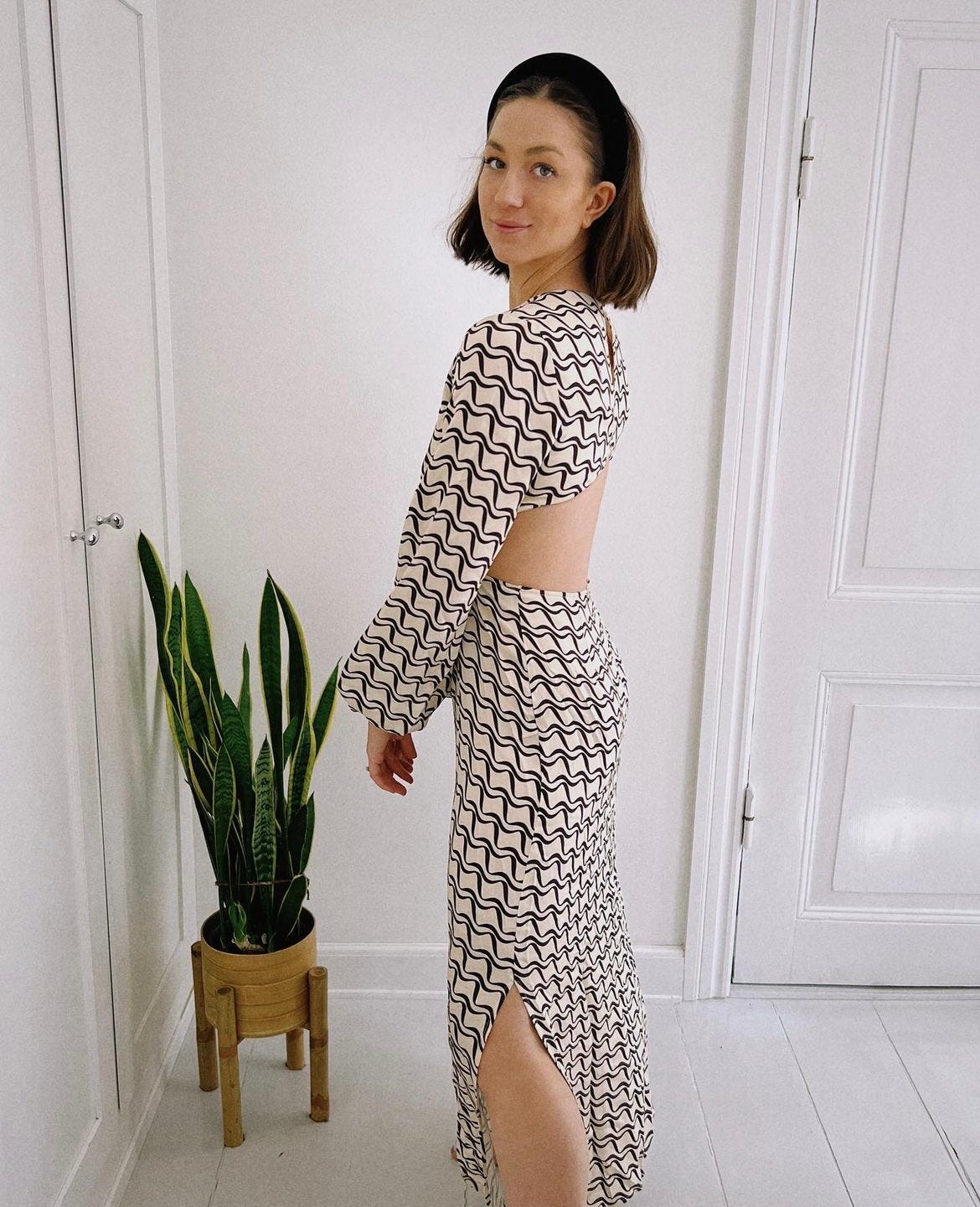Thrifting 101: *HOW* To Find Secondhand Clothing That You Love
TANGIBLE tips for navigating the thrift store in a way you, the environment, (and your wallet!) will appreciate
Okay you guys, GIDDY UP.
Things may seem a little bit different over here today…
Because, while we are typically all about tangible health tips, nourishing recipes, and slow living over here at The Reset, I am switching it up slightly today and talking about sustainable approaches to clothing— specifically THRIFTING.
Why, you may ask?
Well… because YOU GUYS asked.
Over on my insta, I have been asked time & time again to explain the *how* of finding great thrifted pieces, shopping secondhand, saving money on clothing, etc.
Because, TBH, if you’ve been following along, you’ve probably had me respond like this whenever you ask for a “link” to a certain item of clothing. (These 2 DMs were less than a half hour apart, ha!)
Thrifting 101 with Kate:
And the truth is— I’ve been a thrifter my whole life.
In high school you could always find me at Goodwill, Plato’s closet, Savers…I even got my high school prom dress on eBay!
And, to be honest, there was ZERO sustainability factor in mind when I first started.
I just loved that I could get pieces that were cheap— and as a high schooler working at gas station and making minimum wage, that was my main motivator.
But as I’ve gotten older I’ve begun to appreciate thrifting and shopping secondhand for way more than just the price point —
It allows me to find more unique pieces, source amazing vintage, reduce my environmental impact, annnnnnnd (of course, still) saves a lot of money.
^^This olive green button down is one of my FAV secondhand finds of all time.
So, today we are breaking down the nitty gritty of thrifting.
AKA *HOW* to buy used clothes and find amazing vintage pieces at a good price:
why buying secondhand & “slow fashion” important to me,
the mannnny reasons why I like thrifting,
some VERY tangible tips for finding quality, stunning pieces,
hacks for shopping in-person & how to navigate a thrift store,
my tips for thrifting & buying secondhand online,
my FAVORITE places to thrift online (I’ve been gatekeeping this forever…)
And, um, maybe even a secret link to me selling MY clothes (!!!).
But, overall, HOW I have curated a wardrobe full of thrifted pieces that have saved me money, helped the environment, and given me a unique, timeless wardrobe
Thrifting works for ANY style—
As you may know, my signature fashion sense is apparently “a semi-trendy high school biology teacher” or “kind of timeless like Jacqueline Kennedy…. but like a Jackie O who also camped and went to Woodstock” (these are actual ways you guys have described my style, ha)!
But no matter what particular *lewk* you’re searching for, shopping secondhand is SUCH an incredible way to reduce your environmental impact while still finding gorgeous and unique pieces that are perfect for YOU.
… AND be better for the environment than buying everything brand new.
^^Remember that time when I asked you guys to describe my style and you said “a kind of trendy biology teacher” and a “modern jackie kennedy… but like a jackie o. that would go camping at woodstock”. HAHAHHA. Hi, I’m Mrs. Eskuri, and I will be your 9th grade science teacher today?!
Environmental Impact
TBH, I used to be a TOTAL fast fashion girlie. Until 2017, I lived in the Forever 21 clearance section, stocking up on $4 tank tops and $12 jeans, without much thought about why these clothes were so cheap and why needed yet ANOTHER black t-shirt in my already-full closet.
But, then… I watched “The True Cost”, a documentary about fashion, consumerism, capitalism, exploitation of garment workers, pollution, etc., and my mind. was. blown. (I HIGHLY recommend watching the documentary if you haven’t!).
I had never even considered my clothing and shopping habits as a harm to environment, but the facts on fashion indsutry show otherwise—
The fashion industry is the world's SECOND-largest polluter…. right behind oil! This SHOCKED me. But once I learned it, I couldn’t unlearn it.
The world consums 80 billion (with a B!) pieces of clothing each. year. (This may be hard to grasp, but just know it is up approximately 400% from two decades ago…….)
Only 10% of the clothes people donate to charity/thrift stores are actually sold. Woof. This was striking. I had always felt “good” about my donations, but it turns out most DON’T get purchased and just end up in landfills (ahem, 12 million tons of textiles and fabrics are sent to american landfills each year)
One of the best ways you can live sustainably is by considering where your money goes, especially when it comes to material purchase — this truly MATTERS, and thrifting is one of my favorite ways to give some love to the environment!
You are saving a piece from going to the landfill *and* it is one less item that you have to buy from the fast fashion, overly consumeristic world. It may seem small (and, I acknolwdge, in some ways it is…), but it can be empowering to TAKE some of your power back with the clothing industry! It always feels like a mini win every time I get something thrifted instead of new.
So, now that we’ve reviewed the importance of thrifting, let’s get into my full breakdown of everything you need to know about HOW to find pieces you love—
My general approach to clothing
While I am definitely not perfect, I sort of use a hierarchy method or flow chart when it comes to making my clothing purchases, and it goes like this:
1) use what you have (!!!!),
2) buy used or borrow from a friend,
3) purchase from slow fashion brands,
4) only buy something new if it’s a “hell yes,” and finally
5) rent for special events.
RULE 1: Use what you have (even if it’s fast fashion!)
The first and foremost thing you can do is use what you already have — yes, even if it’s fast fashion. When it comes to sustainability and clothing, I would argue it’s better for you to wear that Forever 21 shirt you bought in college over and over again than to throw it away and go out and replace it with something more “sustainable” – it is better for the environment to work with what you’ve got!
But that said, we all like new pieces and sometimes need to replace things, so here’s a hierarchy you can follow when it IS time to get something “new”:
2.Thrift, borrow, or buy used
This is a great sustainable option because the garment you’re purchasing is already produced so you aren’t creating a need for a brand-new garment to be created.
3.Buy from slow fashion brands
“Slow fashion” clothing can mean a variety of things: maybe the piece is from a small business, maybe the business is women-owned, or maybe the garment made with sustainable fabrics, but the ethos is that these clothing pieces aren’t mass produced, aren’t made with child labor or unfair wages, don’t use unsustainable practices, don’t have a bunch of chemicals in the fabrics, etc.
It can mean a lot of different things to a lot of different people, but basically it’s buying QUALITY clothing that is made in ethical conditions. (This could be a whole post on its own— let me know if you want a recap on slow fashion 101: what does it mean, brands to look for, etc.)
4.Only buy if it is an absolutely HELL YES (“good enough” is not good enough)
So for me this was an absolute game changer. I was the QUEEEEEEN of buying things that were “good enough” or just purchasing an average shirt because it was only $8 on sale, but in 2017 (again, after watching The True Cost), I started only buying pieces I KNEW I loved and would wear again and again.
And those are what I call the “hell yes” pieces. Ya know, the ones you see and immediately know that it was meant for you— it’s flattering. it’s a color you love. it works with items you already have. etc. etc. etc.
Basically, it’s a piece that I reach for over and over again (whereas the ones I bought simply because they were that “good enough”…. I never wear. ) So, even if they cost a bit more up-front, build your wardrobe with things that are HELL YESes— you deserve to LOVE your clothes.
It took me a while to get over sticker shock, but I’ve come to realize I would rather buy one $80 shirt that I am OBSESSED with (and will wear 100+ times) than buy 10, separate $8 mediocre shirts that I will wear once each (maybe). It costs the same amount, but the clutter, waste, and intention is sooo different.
5.Rent from Nuuly for special events
Okay, but…. sometimes ya just CAN’T (or don’t want to) ruthlessly thrift, borrow, or rewear. I get it. We’re human.
I personally LOVE fashion. I love putting together unique pieces for a wedding or vacation, and I used to feel the need to buy new pieces every time I had something on the calendar.
Enter: Nuuly. Not sponsored of course, but I looooooove renting from them a few times a year for specific events or just simply to try some new pieces or garments from fast fashion brands that I don’t like purchasing from. With Nuuly I can rent those pieces and be done with them, and they can be passed to the next user.
Picture it: one dress being worn by seven different people to a wedding instead of each of us buying our own dress? SO much better.
Are services like this perfect from a sustainability standpoint? No, I don’t think so. But, to me, it’s better than buying a brand new piece for every wedding, event, bachelorette party, and wearing it once. I think it’s such a cool, circular way to try trendy pieces more sustainably! This is the last step of my hierarchy of sustainable shopping, and it has come in clutch! (Not sponsored, but my refer-a-friend link saves ya $20 on your first box!)
This is a PERFECT example of how I use nuuly. I recently had a trip to Copenhagen which I wanted some “new” pieces for. I LOVE getting a few pieces for a trip, bachelorette weekend, wedding, etc. because they are things that I would love to wear, but don’t necessarily need in my “real life”… so renting them is perfect! (Click here to save $20 on your first nuuly box!)
Okay, now that we covered my general clothing “hierarchy”, let’s focus on 4 tangible tips to become a thrifting master:
This first section is fully of tips to help you specifically with IN-PERSON thrifting— goodwill, savers, curated thrift shop, etc.. While these tips can be applied to online shopping, as well, I find them particularly relevant as you enter a thrift store:
1.Have a *specific* vision
When you go into a thrift store, I encourage you to have a specific vision or ~vibe~ in mind. Like, “today I’m looking for business casual pants for work” or “today I am looking for a coastal grandma sweaters” or “today, I am looking for outdoorsy hiking clothes” and *only* look for things related to that vision.
Sure, you may find some other things and sometimes it is fun to “just wing it”, but, in general, having a bit of an intention this sets a purpose to your shopping, improving your likelihood of a successful thrifting trip!
It can be so overwhelming to go into a thrift shop with hundreds (or even thousands!) of items, and unless you have a specific item or clear vibe that you’re looking for it can be easy to get distracted and feel overwhelmed. So, set a list of 1-3 things or vibes you are looking for before you start exploring!
2.Keep track of your closet gaps
Going off of that^^, I highly recommend having a tangible list of items you are needing in your closet. The way I do this is by keeping a running bulletpoint list in my Notes app of what pieces I’m looking for or what gaps I have in my closet. High waisted black jeans. A tan blazer. A leather crossbody purse. Just keep a list of things that you really want or need can again, help you focus and find what you’re actually looking for. This is something I do EVERY time I go thrifting and it helps me so much to stay focused and truly only get things I *need* (because, left to my own devices, I would get distracted and leave with YET ANOTHER olive green sweater even though I already have 4 *face palm*)
3. Love a fast fashion piece? Do this.
Every once in a while I’ll see something from a fast fashion site that I LOVE. Like, a “hell yes”, I NEED that item kind of love. Buuuut…. while I want to to support fast fashion or spend $150 on it (looking @ u, Free People).
When this happens, I just save the specific name of the item to a list on my phone and then in 3-6 months I’ll type that specific name into Poshmark or eBay. Trust me — someone is almost ALWAYS selling that exact piece! So not only will you save an item from going to a landfill or just being tossed aside in someone’s closet, you’re getting to reuse an item that was already created AND save money in the process.
While some may argue that the fast fashion item is still being used, no one is perfect — no one is going to have 100% slow fashion everything. So if there’s a fast fashion item you like, just save the name of it, the size you would like, and search for it later. (Another bonus of this is that sometimes when a few months go by you’ll realize you forgot about it! AKA, you probably didn’t even want it that badly in the first place, so it’s a way to vet your purchases as well!)
4.Do not fear the men’s section (!!!)
Don’t sleep on the men’s section, guys! When it comes to loose sweaters, jeans, vintage crewnecks, Ralph Lauren style button ups, I looooooove thrifting the men’s section for oversized casual items. Plus, many women don’t look in that section so I feel like it’s not as picked over.
Now, that we got those 4 in-person thrifting tips in, I am going to explain my *personal* approach to ONLINE secondhand shopping— HOW I do, it, HOW to search, WHERE to shop, and a link to my closet sale, etc.
My FAVORITE place to thrift online… (Can’t believe I’m sharing this)
Another thing I get asked about a ton is where I buy a lot of my thrifted items. I think a lot of people think I’m finding everything at Goodwill or in-person, and that’s not necessarily the case.
In fact, I would say that 80% of my recent “thrift” finds have actually been purchased online.
There are so many amazing online secondhand sales where people curate phenomenal items and sell them on Instagram or a website. (I find this to be a great place to find more “name brand” items, quality slower fashion brands, nicer items, or more expensive brands compared to your local goodwill).
Now, I contemplated continuing to gatekeep this, but for you, my Substack community, it’s finally time to share my absolute favorite place to shop for secondhand items online… I am not kidding when I say like 60% of my closet is from this one website, and it’s called…








